In this 10-29-21 issue of “Market ‘Melts Up’ As Economic Growth Weakens.”
- Market Back To Extreme Overbought
- Economic Growth Weakens
- Earnings Expectations Way Ahead Of Reality
- Portfolio Positioning
- Sector & Market Analysis
- 401k Plan Manager
Follow Us On: Twitter, Facebook, Linked-In, Sound Cloud, Seeking Alpha
Is It Time To Get Help With Your Investing Strategy?
Whether it is complete financial, insurance, and estate planning, to a risk-managed portfolio management strategy to grow and protect your savings, whatever your needs are, we are here to help.
Schedule your “FREE” portfolio review today.

Market Back To Extreme Overbought
With earnings season in full swing, stocks continued to push higher this week. Even disappointing earnings from Starbucks, Apple, and Amazon couldn’t keep the bulls down much. So far, the earnings season has pretty much aligned with expectations. As noted by FactSet:
“Overall, 56% of the companies in the S&P 500 have reported actual results for Q3 2021 to date. Of these companies, 82% have reported actual EPS above estimates, which is above the five-year average of 76%. If 82% is the final percentage for the quarter, it will mark with the fourth highest percentage of S&P 500 companies reporting a positive earnings surprise since FactSet began tracking this metric in 2008. In aggregate, companies are reporting earnings that are 10.3% above estimates, which is also above the five-year average of 8.4%.”
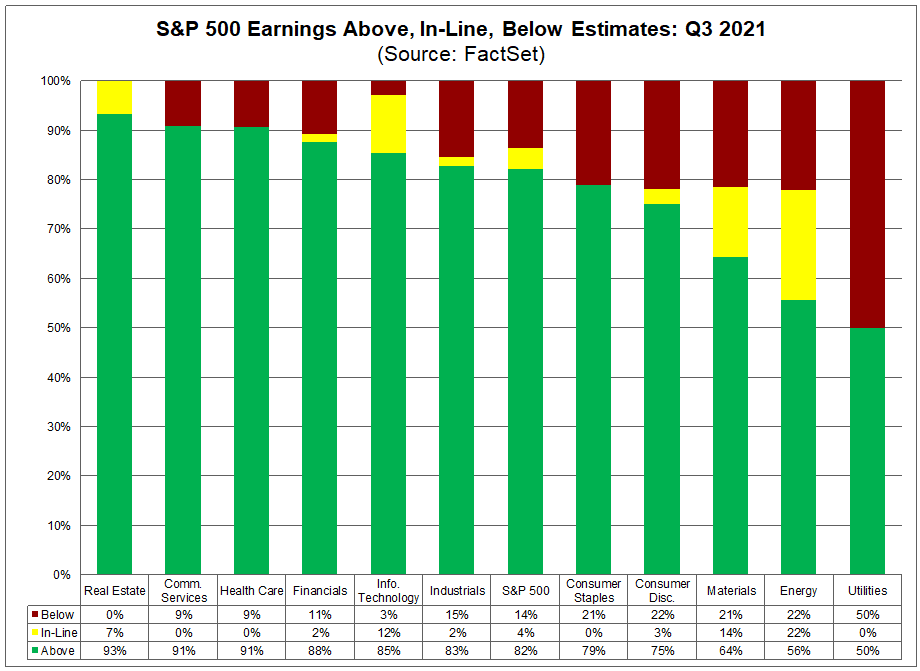
Earnings have indeed been very impressive, but as we will discuss, this quarter will likely mark the peak of growth for a while.
The more significant concern, however, remains the underlying technical condition of the market. While the rally has been impressive, rising almost 6% from the recent lows, the market is now back to more extreme overbought levels, trading 2-standard deviations above the 50-dma, and breadth remains troubling.
Chart updated through Friday.
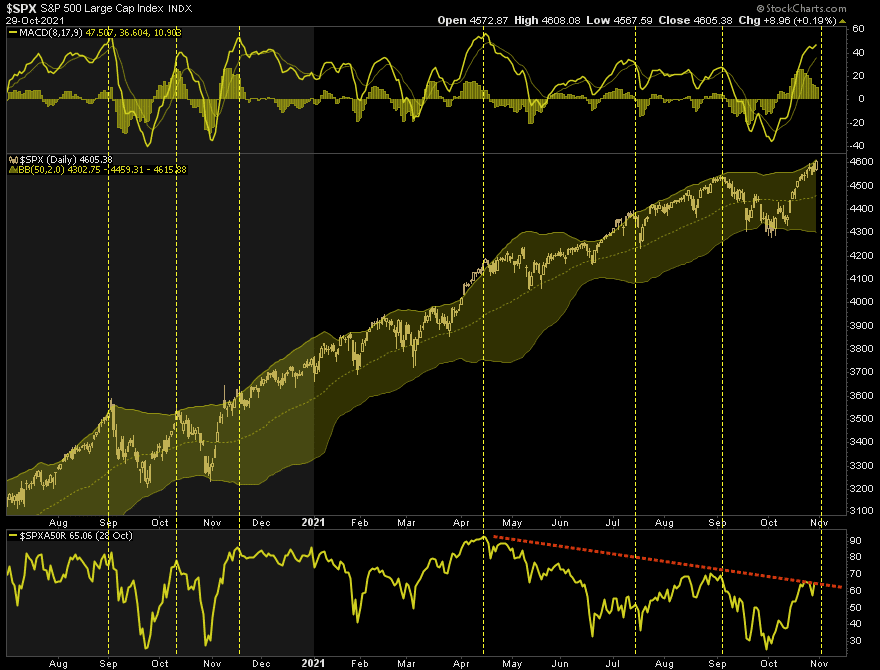
As noted last week, our “money flow buy signal” is near a peak and is close to triggering a “sell signal.” With the MACD still positive, the signal suggests more consolidation than correction. However, a confirming MACD often aligns with short-term corrections at a minimum. Also, as shown, this entire rally from the recent lows has been on very weak volume, which suggests a lack of commitment.
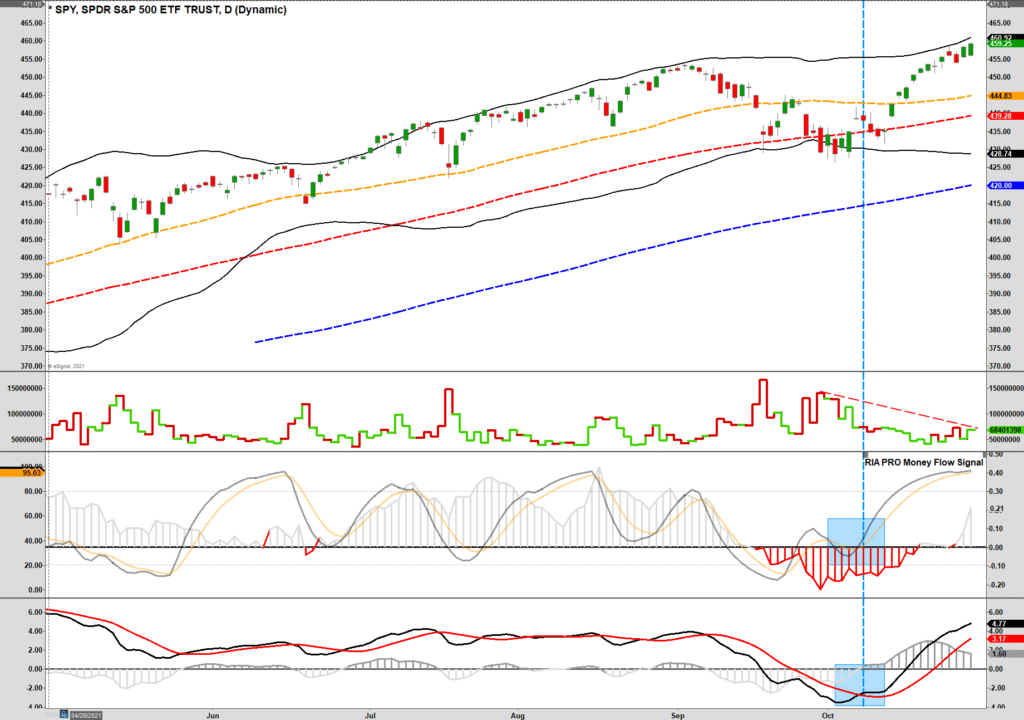
At the moment, the bulls control the market, and downside risk is somewhat limited. However, that positioning is getting very aggressive.

Aggressive Positioning
As noted, the current spat of economic weakness, combined with rising inflationary pressures, doesn’t bode well historically for asset markets. However, the recent 5% correction did little to reverse more aggressive positioning. As shown below, the NAAIM Index (Fund manager positioning) has surged back levels that have previously aligned with short-term corrections or worse.
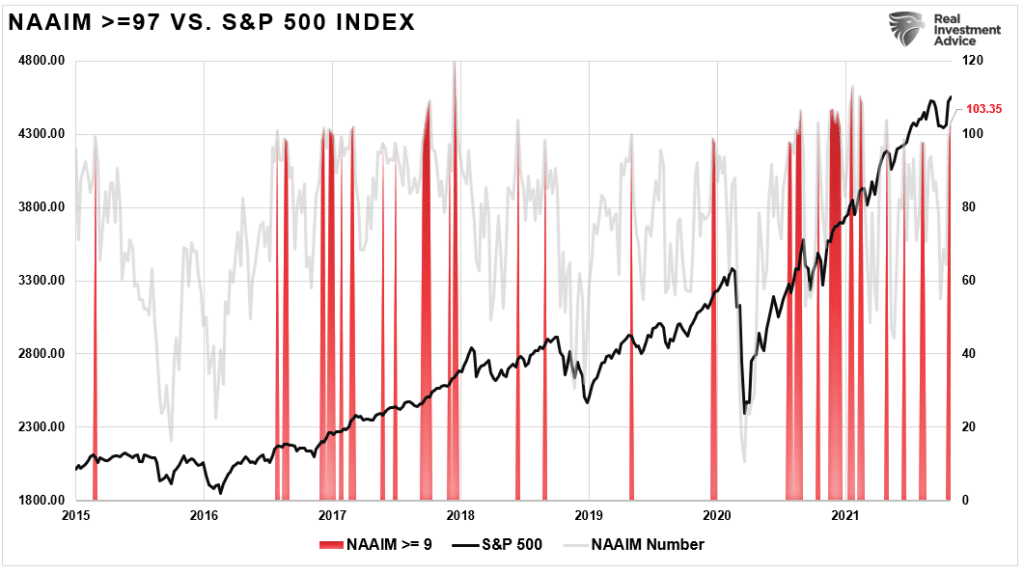
Such is not surprising given the massive inflows of capital into the market this year alone which have now exceeded $1 trillion. (Chart courtesy of Zerohedge)
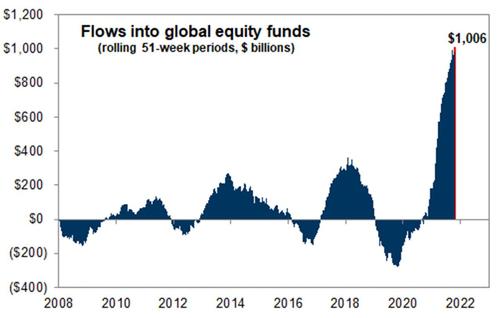
Furthermore, with the window for corporate share buybacks opening in November, the primary buyer of equities will return to the market. Share buybacks are already at a record and could add as much as $90 billion to the total by year-end.
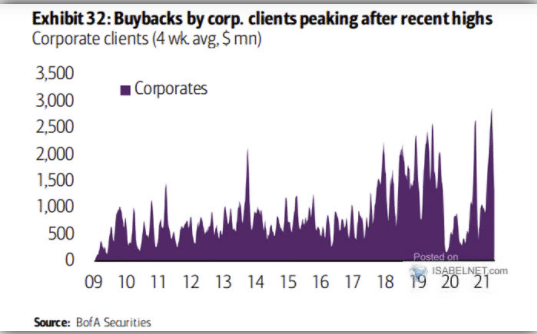
While capital flows certainly support the bullish narrative in the short-term, such can get easily reversed with a change in sentiment. As noted, with economic growth weakening and inflation increasing, the risk of a reversal is increasing. Moreover, the chart shows that previous spikes in inflation have not been kind to equity returns.
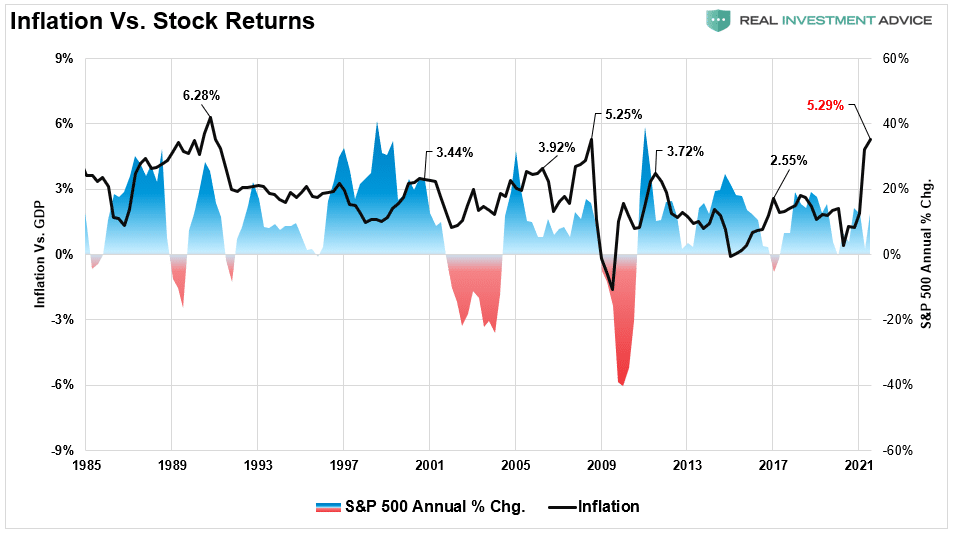
Of course, inflation also hurts economic growth which impacts profit margins.
Economic Growth Weakens
In March of this year, I penned an article entitled “Sugar Rush,” wherein we discussed the economy would run “hot” and then “crash.” At the time, I received a lot of “pushback” on my “dire predictions” of economic growth later in the year. Furthermore, I followed that analysis asking if Q2 was the “Peak Of Economic Growth?” To wit:
“Was the second quarter the peak of economic growth and earnings? If estimates are correct and the year-over-year ‘base effect’ fades, such suggests risk to current earnings estimates. The chart from a “Grossly Defective Product,” utilizes the Atlanta Fed’s current estimates for Q2-2021 GDP. The full-year estimates are from JP Morgan. Notably, the economy quickly slows to 2% heading into 2022.”
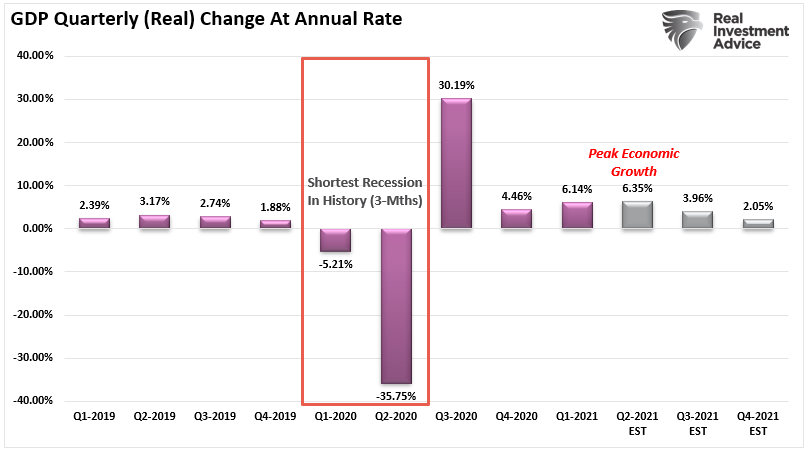
At that time, we estimated less than a 4% growth rate for the economy, with the Atlanta Fed well above 6%. On Thursday, the initial release of Q3 GDP came in well below even our lowered expectations of just 2%.
“Real gross domestic product (GDP) increased at an annual rate of 2.0 percent in the third quarter of 2021 (table 1), according to the “advance” estimate released by the Bureau of Economic Analysis. In the second quarter, real GDP increased 6.7 percent.” – BEA
Notably, the “advance estimate” is derived from a sampling of economists’ estimates. As actual data gets factored into the GDP calculation during the next two months, the growth estimates will get revised. As discussed in “The Bullish/Bearish Case,” the weakness in the economic data suggests those GDP revisions will be lower.
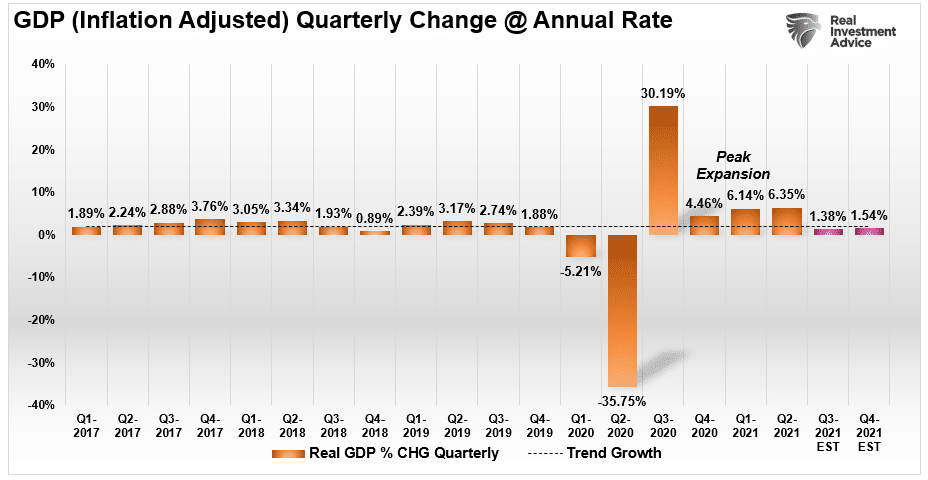
The implications of weak economic growth are broad. Consumer sentiment will remain weak as inflationary pressures undermine consumption. Furthermore, the negative impact on earnings seems to elude investors currently.
In Case You Missed It

Earnings Expectations Way Ahead Of Reality
Despite economic growth weakening as inflation increases, liquidity reducing, and profit margins under pressure, analysts continue to increase their earnings estimates. Currently, estimates for the Q4-2022 are $207/share according to S&P. As shown, that level will exceed the historical 6% exponential growth trend that contained earnings growth since 1950.

Currently, earnings expectations exceed the annual exponential growth trend by one of the most significant deviations on record. The only other two periods with similar deviations are the “Financial Crisis” and the “Dot.com” bubble.

With analysts extremely exuberant, there seems to be little concern for investors. However, I would caution against such complacency.
The chart below is the Economic Output Composite Index. The index comprises the CFNAI, Chicago PMI, ISM Composite, the Fed surveys, Markit Economic Index, Markit PMI, NFIB, TIPP Confidence, and the LEI. In other words, this indicator is the broadest indicator of the U.S. economy there is.
The last complete set of data is through September. Notably, the index peaked at the second-highest level on record. When October gets fully accounted for, the index will decline further.
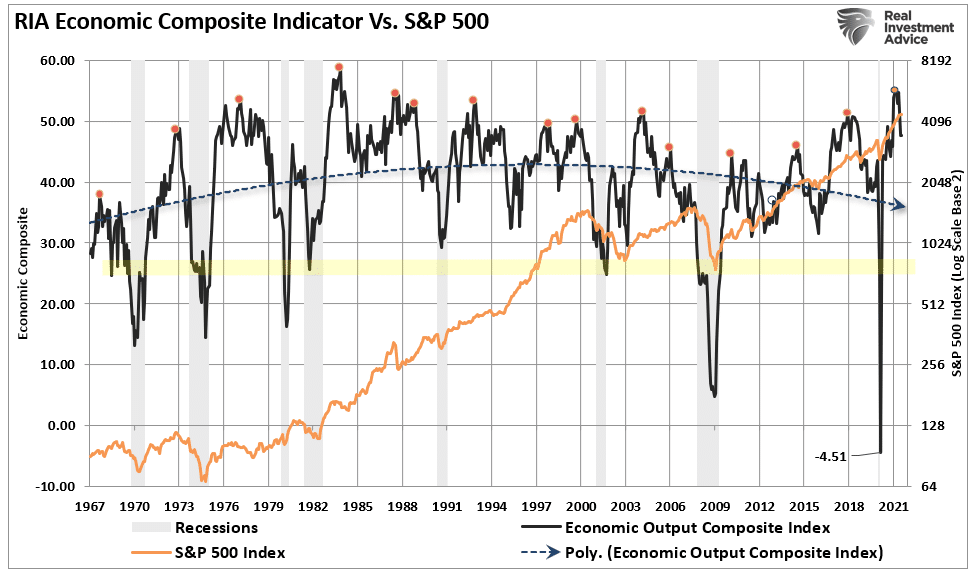
There are two critical takeaways from the EOCI index: 1) the stock market tends to either correct or fall into a bear market during reversals, and 2) there is a high correlation between the index and the annual change in earnings.

As we have noted previously, with the Fed beginning to “taper” bond purchases, the risk to investors continues to rise as earnings peak and profit margins contract.

Portfolio Update
While anything is possible in the near term, complacency has returned to the market very quickly. As noted, while investors are very bullish, there are numerous reasons to remain mindful of the risks.
- Earnings and profit growth estimates are too high
- Stagflation is becoming more prevalent (weak economic growth and rising inflation)
- Inflation indexes are continuing to rise
- Economic data is surprising to the downside
- Supply chain issues are more persistent than originally believed.
- Inventory problems continue unabated
- Valuations are high by all measures
- Interest rates are rising
Furthermore, as noted above, there is limited upside as the annual rate of change in the market declines.
So what do you do?
As discussed recently, we believe additional equity exposure gets warranted due to the bullish case. However, the longer-term dynamics are more bearish.
For now, we remain optimistic about the markets due to liquidity, seasonality, and bullish sentiment. As such, we maintained our equity exposures again this week.

However, we are beginning to hedge risk slightly heading into the Fed meeting next week. With oil extremely extended, we rebalanced energy stocks back to model weights. We also started building a position in “volatility” to hedge our long-equity holdings against a sudden decline.
What could cause such a decline? No one knows. However, everyone seems to believe it can’t happen.
That is usually just about the time it does.
Have a great weekend.
By Lance Roberts, CIO
Market & Sector Analysis
Analysis & Stock Screens Exclusively For RIAPro Members
S&P 500 Tear Sheet
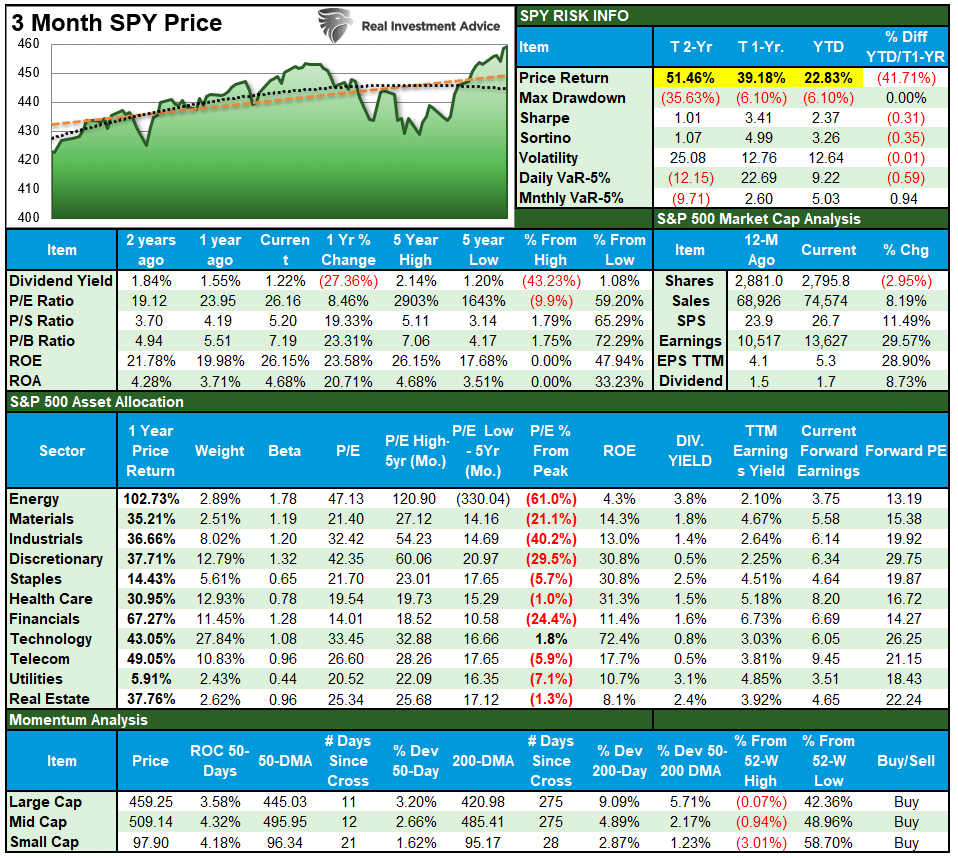
Performance Analysis
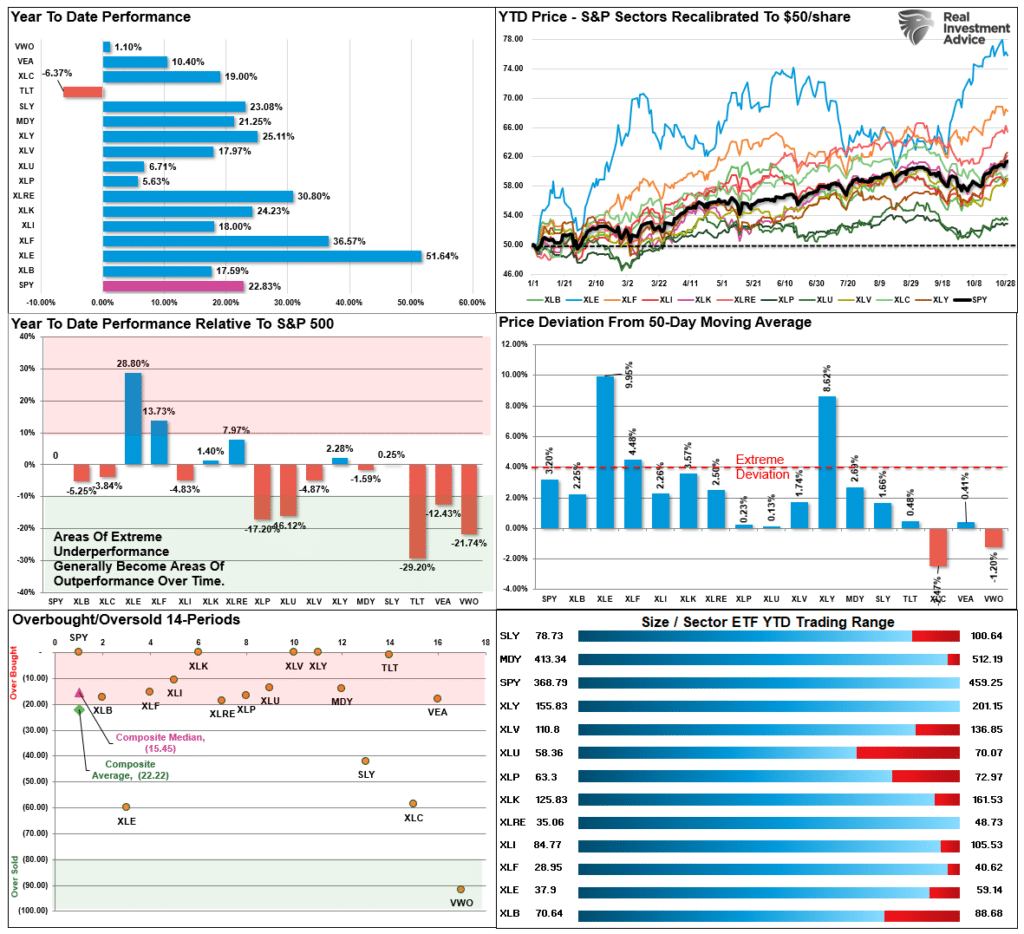
Technical Composite
The technical overbought/sold gauge comprises several price indicators (RSI, Williams %R, etc.), measured using “weekly” closing price data. Readings above “80” are considered overbought, and below “20” are oversold. The current reading is 84.32 out of a possible 100.
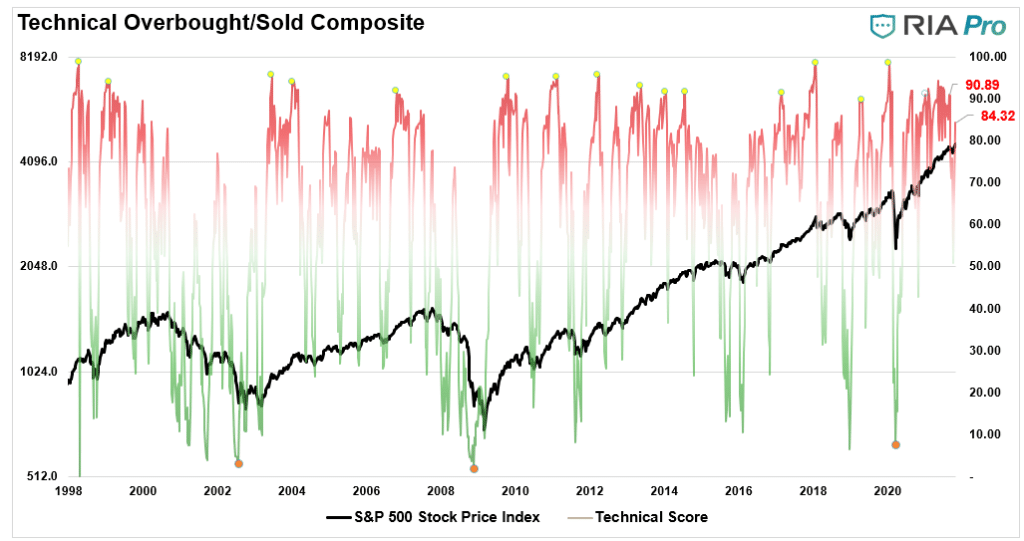
Portfolio Positioning “Fear / Greed” Gauge
Our “Fear/Greed” gauge is how individual and professional investors are “positioning” themselves in the market based on their equity exposure. From a contrarian position, the higher the allocation to equities, to more likely the market is closer to a correction than not. The gauge uses weekly closing data.
NOTE: The Fear/Greed Index measures risk from 0-100. It is a rarity that it reaches levels above 90. The current reading is 88.34 out of a possible 100.
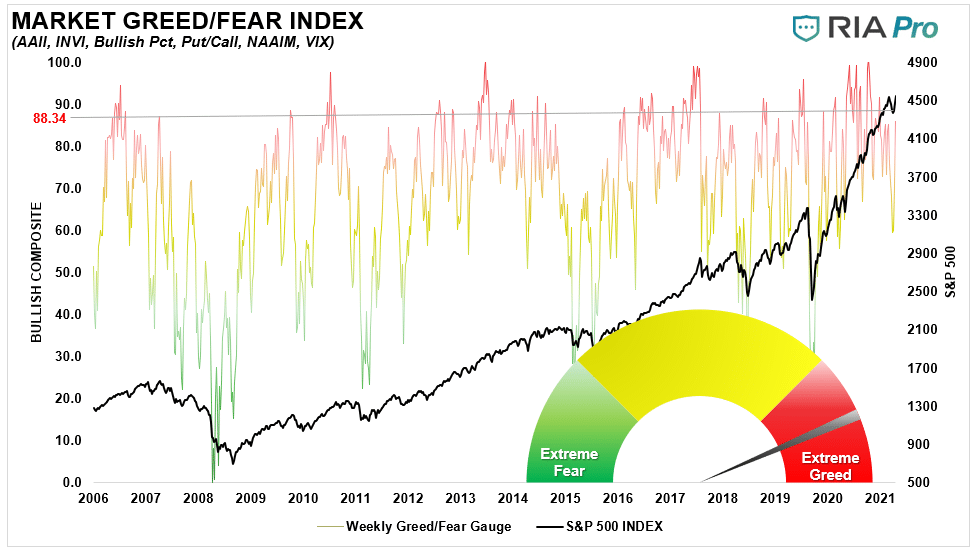
Sector Model Analysis & Risk Ranges
How To Read This Table
- The table compares each sector and market to the S&P 500 index on relative performance.
- “MA XVER” is determined by whether the short-term weekly moving average crosses positively or negatively with the long-term weekly moving average.
- The risk range is a function of the month-end closing price and the “beta” of the sector or market. (Ranges reset on the 1st of each month)
- Table shows the price deviation above and below the weekly moving averages.
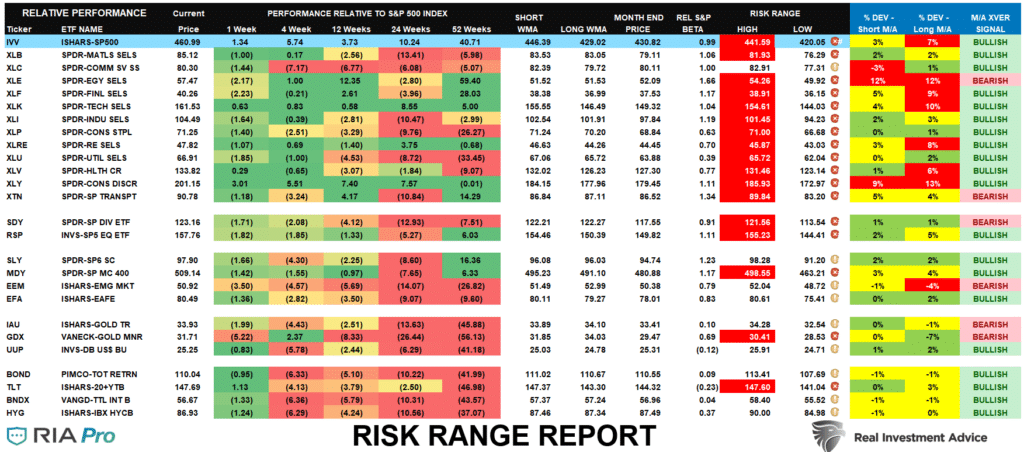
Weekly Stock Screens
Currently, there are four different stock screens for you to review. The first is S&P 500 based companies with a “Growth” focus, the second is a “Value” screen on the entire universe of stocks, and the last are stocks that are “Technically” strong and breaking above their respective 50-dma.
We have provided the yield of each security and a Piotroski Score ranking to help you find fundamentally strong companies on each screen. (For more on the Piotroski Score – read this report.)
S&P 500 Growth Screen
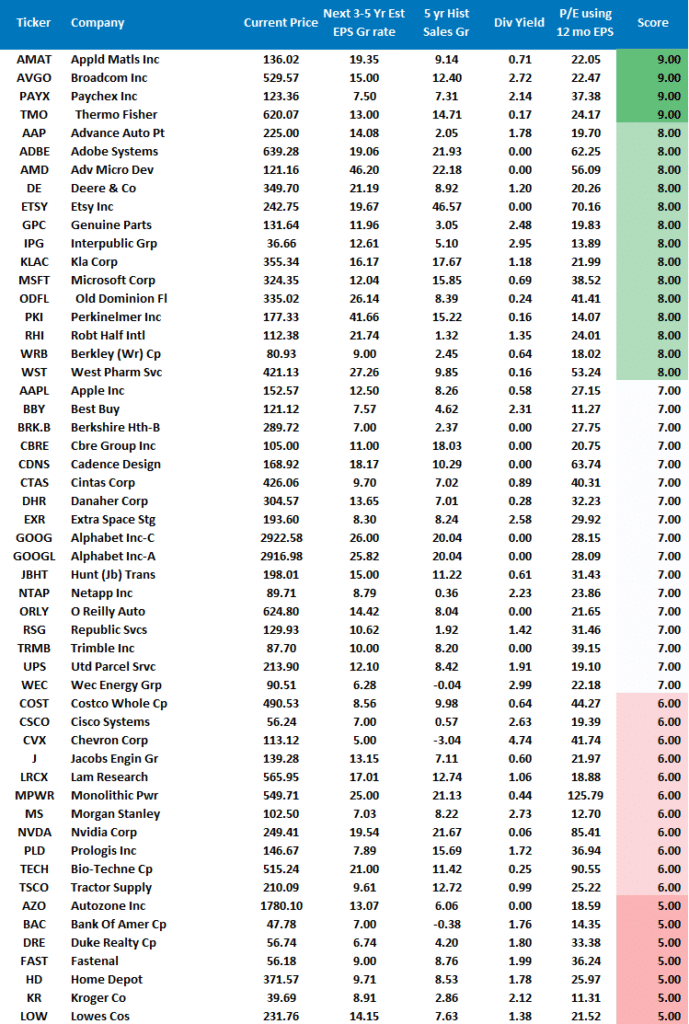
Low P/B, High-Value Score, High Dividend Screen

Fundamental Growth Screen
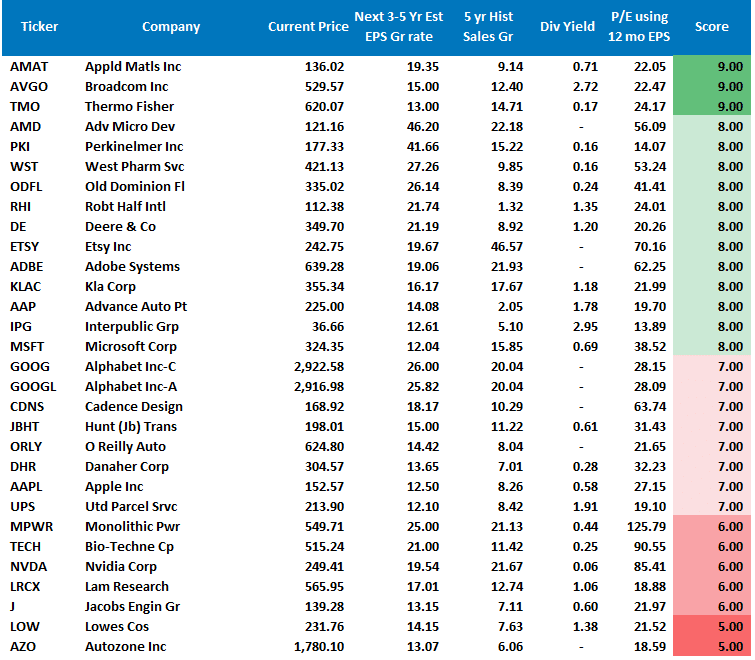
Aggressive Growth Strategy
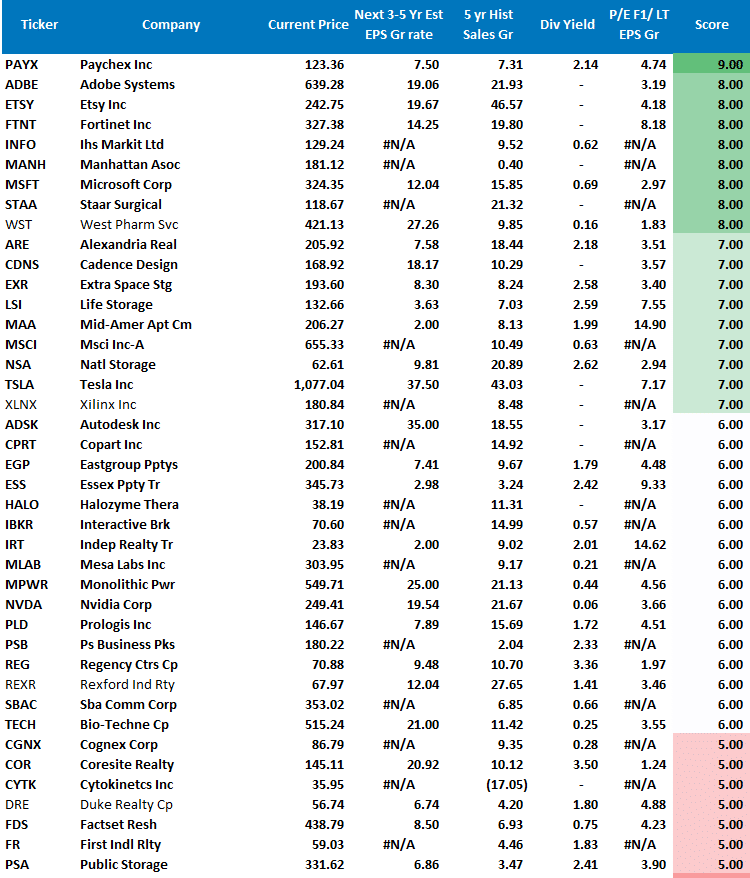
Portfolio / Client Update
This week, the market continued its bullish advance again and is now pushing back into more extreme overbought levels. As such, our recent additions to the portfolio have performed well. Currently, our portfolios continue to outperform our global benchmark by roughly 300 basis points with lower volatility than the S&P 500 index.
There wasn’t much to do in portfolios last week. Several stocks did exceptionally well (NVDA, F, MSFT), which gave the whole portfolio a boost. Furthermore, we reduced our energy exposure back to model weights as oil is getting extremely extended currently. We continue to watch interest rates closely as it looks like we may be approaching another “buy point” to increase our duration in our bond holdings further.
With the Fed on deck to “taper” bond purchases next week, we also added an “equity hedge” to portfolios. Our concern is that inflation is running hotter than the Fed anticipated. Therefore, there is a risk the Fed could be more “hawkish” than expected. Such a move could surprise equity markets negatively. Consequently, we will remove the hedge after the meeting regardless of the outcome.
Again, while it may seem counter-intuitive at the moment, the current bout of inflation will turn into deflation next year as liquidity gets drained from the system. Therefore, we continue to manage the deflationary side of our portfolio closely.
As noted, while there seems to be minimal risk in the market, don’t be misled. There are numerous risks we are watching that could lead us to reverse course rapidly. Our job remains to protect your capital first and foremost, but we want to capture gains when we can.
Portfolio Changes
During the past week, we made minor changes to portfolios. In addition, we post all trades in real-time at RIAPRO.NET.
*** Trading Update – Equity and Sector Models ***
“With the market entering a “melt-up” phase on earnings exuberance, we are adding to our VXX position today to hedge against the currently overbought conditions. With the Fed meeting next week, there is a risk of a short-term sell-off if the Fed appears more hawkish than expected.” – 10/28/21
Both Models
- Add 1% of the portfolio to VXX increasing size to 3% of the portfolio.
“This morning we trimmed back on both of our energy exposures (XOM and XLE) back to model weights. The recent run took the positions out of tolerance relative to the portfolio.
We also added a 2% position in VXX (Volatility Index) which has become very suppressed lately. Given the overbought condition of the market, we are looking for a small risk hedge heading into the Fed meeting next week.” – 10/27/21
Equity Model
- Reduce XOM to 2% of the portfolio.
- Initiate a 2% position in VXX
ETF Model
- Reduce XLE to 2.5% of the portfolio.
- Initiate a 2% position in VXX
As always, our short-term concern remains the protection of your portfolio. Accordingly, we remain focused on the differentials between underlying fundamentals and market over-valuations.
Lance Roberts, CIO
THE REAL 401k PLAN MANAGER
A Conservative Strategy For Long-Term Investors

Attention: The 401k plan manager will no longer appear in the newsletter in the next couple of weeks. However, the link to the website will remain for your convenience. Be sure to bookmark it in your browser.
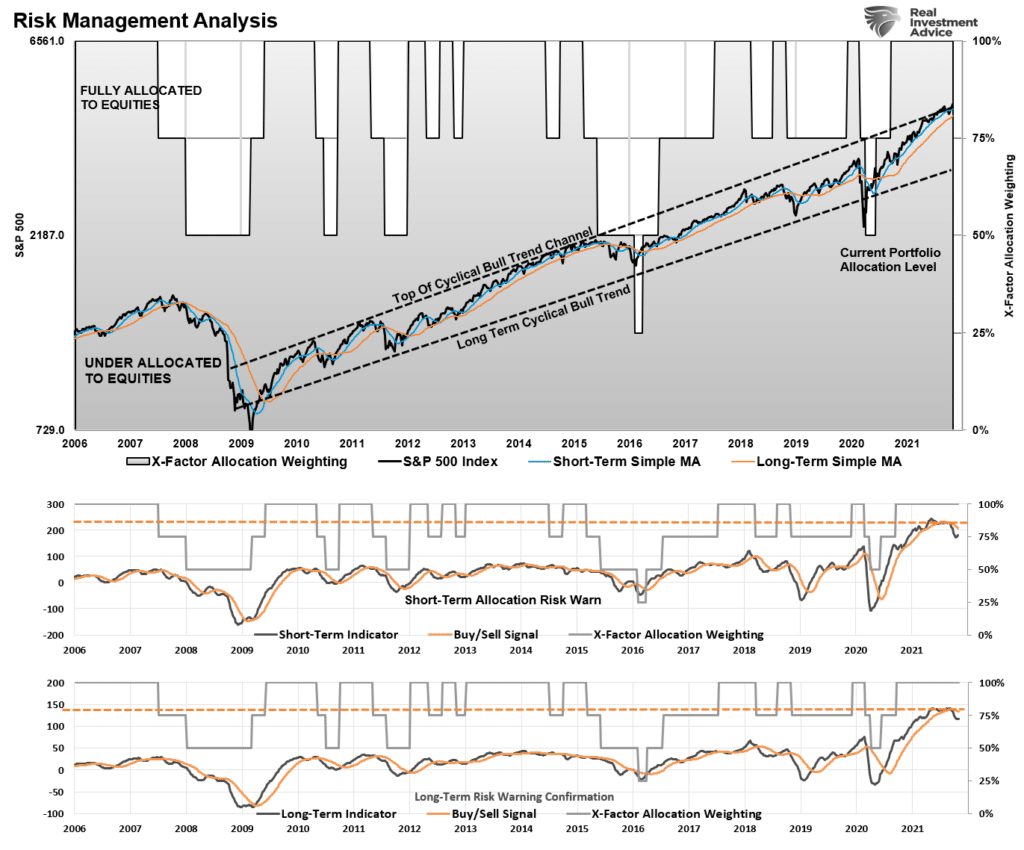
Commentary
The market rally this past week pushed the market further into overbought territory. So while there is no significant risk to the market momentarily, a short-term correction phase would not be surprising.
As such, we continue to recommend rebalancing holdings and reducing your risk heading into November. However, with the Fed on deck to taper their bond purchases, the Democrats about to face a debt-ceiling debate again, combined with weakening economic growth, there is enough to warrant some caution. In the short term, we suggest maintaining exposures in plan portfolios but continue putting new contributions back into cash or stable value holdings for now.
While we have not removed international, emerging, small and mid-cap funds from the allocation model, we suggest avoiding these areas for now and moving those allocations to domestic large-cap.
If you are close to retirement or are concerned about a pickup in volatility, there is nothing wrong with being underweight equities. However, there is likely not a lot of upside in markets heading into next year.
Model Descriptions

Choose The Model That FIts Your Goals
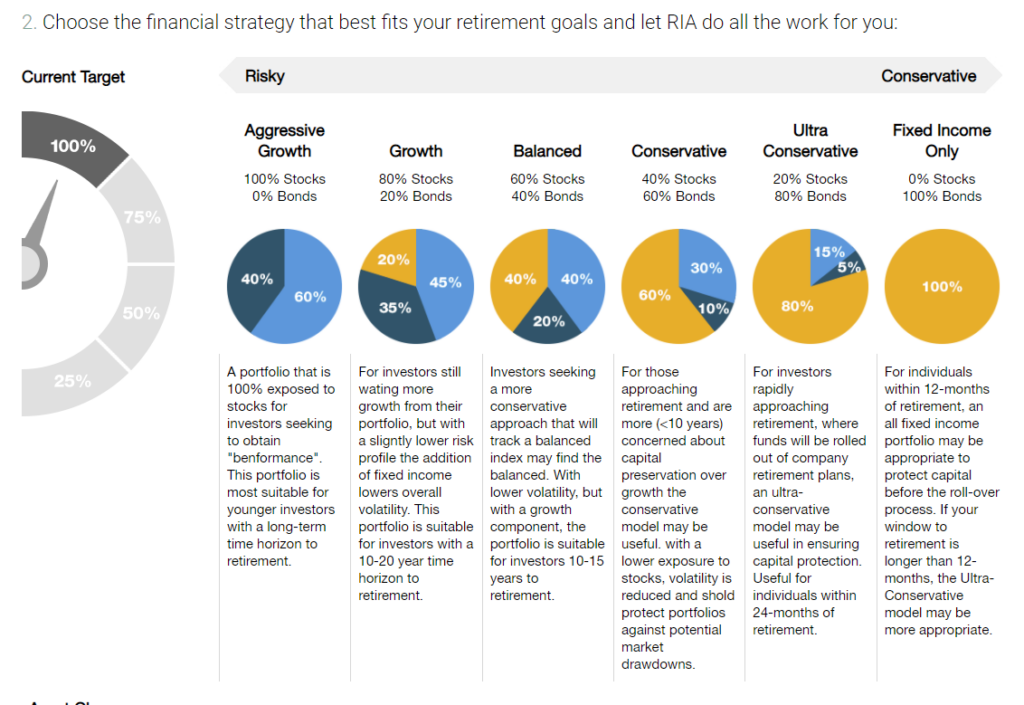
Model Allocations
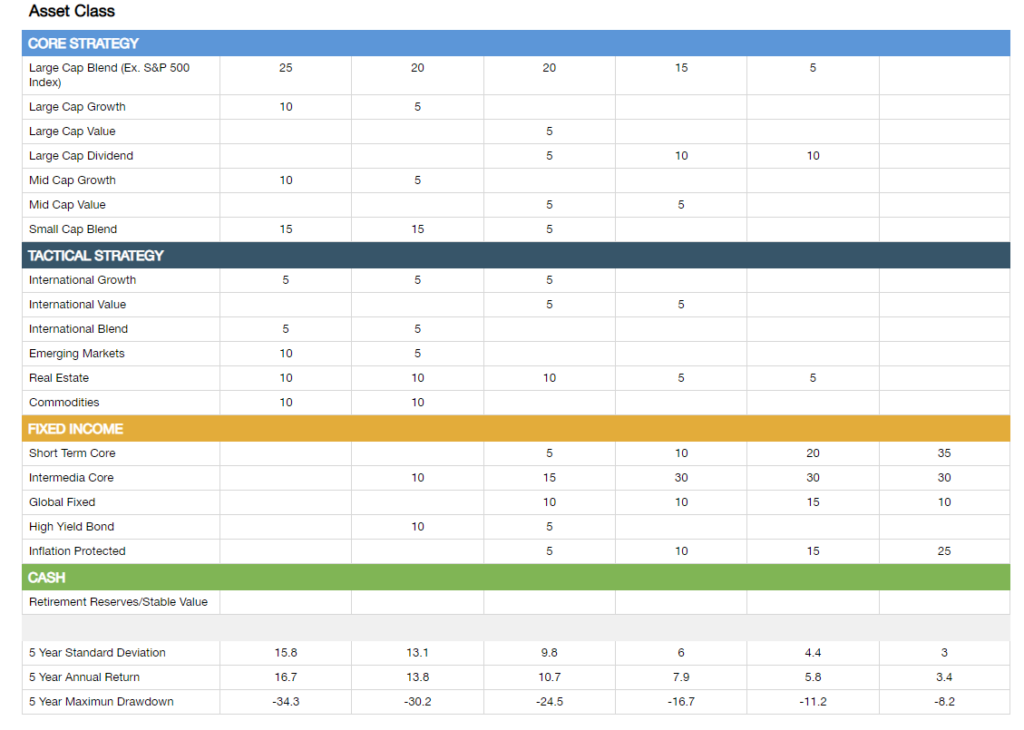
If you need help after reading the alert, do not hesitate to contact me.
Or, let us manage it for you automatically.

401k Model Performance Analysis
Model performance is a two-asset model of stocks and bonds relative to the weighting changes made each week in the newsletter. Such is strictly for informational and educational purposes only, and one should not rely on it for any reason. Past performance is not a guarantee of future results. Use at your own risk and peril.
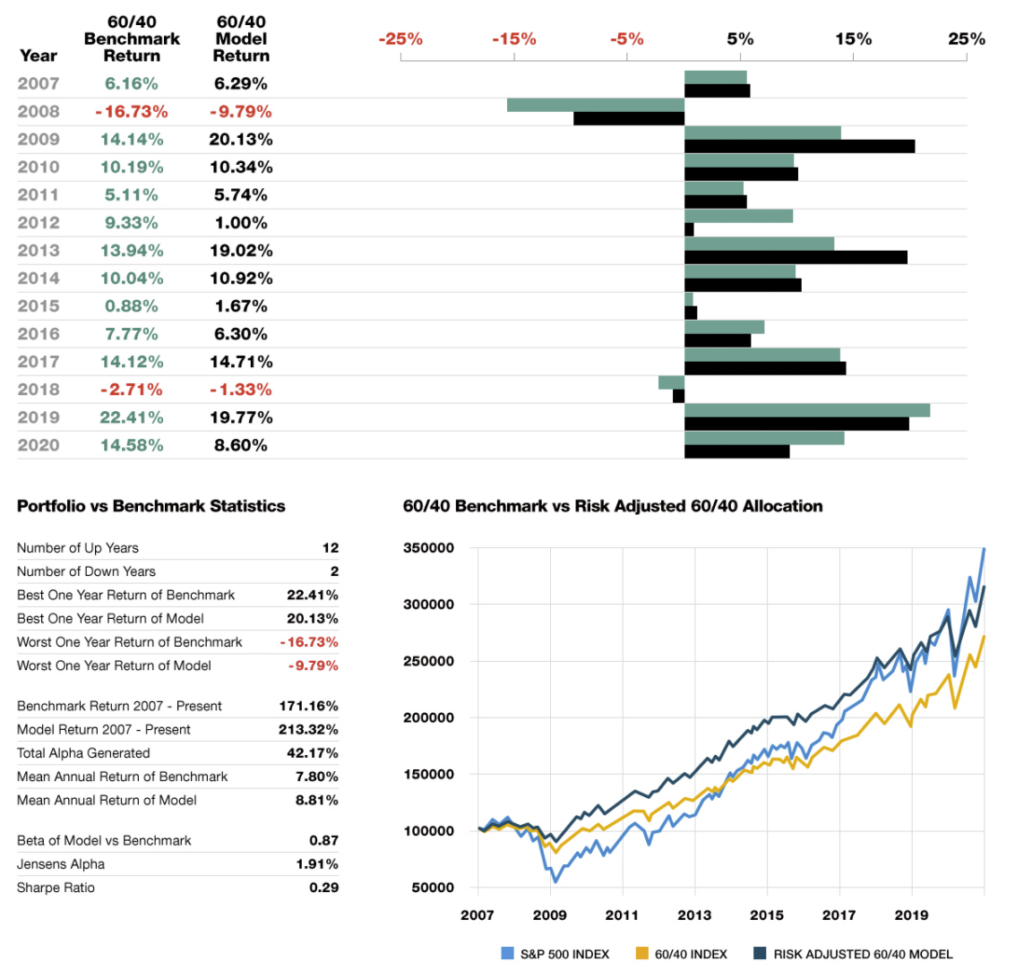
Have a great week!


